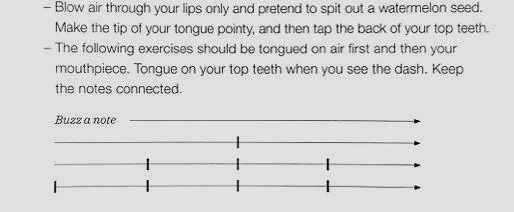Essential Question: How do you make a sound on a brass instrument?
What is a Wind Instrument?
First ask the student why the instrument is called a “Wind Instrument”. Listen to their answer and consider adding these talking points:
Wind=Breath
Wind instruments rely on the controlled motion of breath (airstream) to create sound waves.
Breath is to wind instruments as the bow is to string instruments. The bow moves across the strings to create a vibration. The breath (wind) blows through, across, or over a surface creating vibration.
For brass instruments, energized air is blown into the instrument through carefully shaped lips, which we call our aperture. This creates a vibration. We call that THE BUZZ.
Let’s Make Wind!
**If the kid is young, you might make a fart joke here**
Start with asking the student to take a big breath while standing.
Assess. Watch for tension (bad), abdominal, back, and chest expansion (good), and shoulder motion (excessive rise is bad).
Show them your full breath
Coach a better breath
Coaching a Better Breath
Ask them to show you where their lungs are. Correct them if they aren’t right.
Have them place their hands on their belly, sides and back to feel the natural expansion. They can watch your breath to see the expansion as well.
Remind them to relax their shoulders
Have them sigh to feel how a big breath should feel good
Consider using tools to help facilitate good breathing: augment your demonstration with paper towel tubes, boba straws, or using your finger on lips to create audible feedback
Make a “Brass Face”
All brass instruments are played by Buzzing The Lips.
Vocabulary
Embouchure—the way a brass player uses their lips and facial muscles to make sound on a mouthpiece.
Aperture—the small hole between the lips through which the air flows into the mouthpiece
Famous Chicago Symphony hornist and pedagogue Phil Farkus defines embouchure as “The mouth, lips, chin, and cheek muscles, tensed and shaped in a precise and cooperative manner, and then blown through for the purpose of setting the air-column into vibration when these lips are placed upon the mouthpiece of a brass instrument."
While accurate, that’s too much of a mouthful for a beginning student. Start with simple, familiar words to help a student form a healthy embouchure. Use a mirror and prompt the student to form their face into a “brass face”.
Here are some prompts that may work (note you might not need all of these promts. Experiment with what works and don’t be surprised when different prompts work for different students)
Some Helpful Prompts
A Few Important Reminders
Time to Make Some Noise!
Lick your lips
Form the “brass face”
Place your mouthpiece (exact position depends on which brass instrument and will be discussed in the next few lessons)
Take a big breath, keeping contact between the mouthpiece and top lip
Blow air until a vibration begins. That’s a BUZZ
Add the Tongue
Tonguing on a brass instrument refers to the technique of using the tongue to articulate and shape the start of a note. It involves briefly interrupting or directing the flow of air into the instrument to create a clean and precise attack. More on tonguing later in this lesson.
To control the start of notes.
To provide clarity, rhythm, and definition in musical phrases.
To adjust the style of articulation to match the demands of the music (e.g., staccato, legato, marcato).
Proper tonguing requires coordination between the tongue, air stream, and embouchure to maintain a consistent tone quality.
Placement of the Tongue:
The tip of the tongue lightly touches the area where the upper teeth meet the roof of the mouth .
This is often described as making a "ta" or "da" sound.
Air Flow:
Tonguing should not disrupt the steady air support necessary to create vibration in the lips.
It is more of an interruption, not a forceful stopping.
Beginner Tongue Exercise by Recipe for Success by Houghton and Nye
Playing a Note (and More Notes!)
By adjusting lip tension and air speed, many notes can be played throughout the range without pressing any valves or moving any slides. You can introduce this to beginners right away at the first lesson.
Ask them to play a note. Name the note they are playing.
Then, ask them to make the aperture (hole) smaller by pushing their corners forward and blowing faster air. Use a metaphor like blowing out birthday candles. Most likely, the sound will get louder and the note will jump to a higher note.
Congratulate them on finding a second note. Name that new note.
Have them relax their air speed and find that first note again.
Ask them to get to the second note again.
Then prompt them to blow even faster air. Name any notes they hit.
Then prompt them to relax the lips a little and play with slower air Use a metaphor like blowing bubbles in a bubble wand. Did they find lower notes? Name them.
Encourage the beginner player to make a full sound even if it sounds crackly or raw. At this point it’s most important to practice using good air. Refinement will come with practice.




